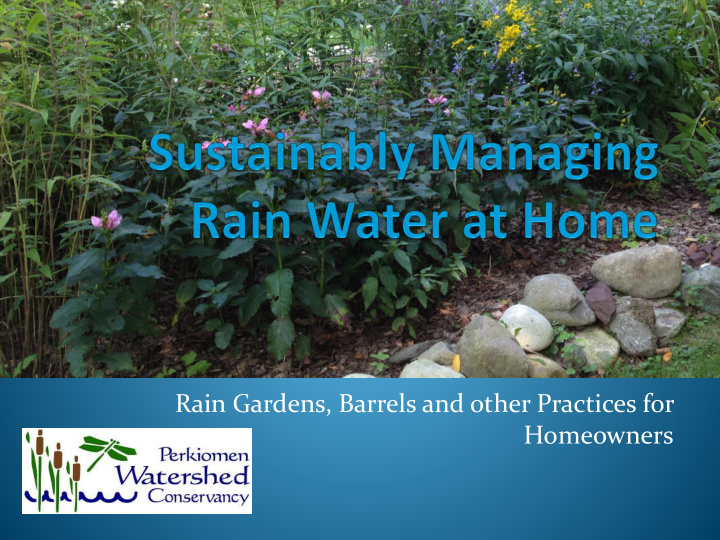



Rain Gardens, Barrels and other Practices for Homeowners
About Us Since 1964, PWC has worked to conserve and protect the natural resources of the Perkiomen Creek Watershed Our Watershed encompasses 362 square miles and 55 municipalities in four PA counties: Berks, Bucks, Lehigh and Montgomery Environmental Education and Conservation programs reach thousand of people each year
What is a Watershed? A stream, creek or river drainage area. It’s boundaries are defined by the natural ridges separating one drainage basin from another.
Rain Water Stormwater Stormwater = rain water, snow melt, or other precipitation that runs off the land and flows downhill or through storm sewer systems to reach waterways.
What we do to the land, we do to the water.
Minimizing Pollution Keep storm drains clear of trash, yard waste and other debris; never dump anything down them. Check vehicles for leaks and have any fixed. Wash your car at a car wash. Cut household chemical use and dispose of them properly . Make sure your septic system is working; have it pumped regularly. Pick up after your pets.
What can you do to manage rainwater on your property?
Install a Rain Barrel or Cistern Store FREE water for outdoor use Provide “soft” water for plants Hold back water to reduce runoff
Rain Barrel Workshop Saturday, October 24, at 10 am Build your own barrel to take home and install for half the price of ready-built barrels! Barrels are limited, register at: www.perkiomenwatershed.org/rain-barrel-building-workshop/
Cisterns
Permeable Pavement Range of sustainable materials and techniques that allow rainwater to be absorbed through the surface. (Video) Pervious concrete Porous asphalt Paving stones Concrete or plastic based pavers Benefits: Reduce stormwater runoff Filter pollutants from rainwater
Meadow Beats Lawn Deep roots encourage infiltration Native perennials use more water Less maintenance; more habitat Resource: Penn State Extension
Black Eyed- Susan Common Milkweed Goldenrod Blazing Star Butterfly Weed Canada Anemone
Plant a Tree Trees benefit: Streams by reducing and treating runoff Wildlife Soil Health Air Quality Community and Human Health
Plant a Bioswale A bioswale is a vegetated depression that captures stormwater run-off form nearby surfaces (e.g. parking lots, roads, roof tops, etc.)
Naturalize existing Water Channels
Build a Rain Garden
Site Selection Source, Soil and Slope Will the soil allow infiltration?
Excavation Dig down 10- 12” Till in amendments until 6” ponding depth Create level bottom; do not compact Excess soil can be used to build berm
Plant Selection Rain Garden Manual of New Jersey Lowimpactdevelopment.org
Cost of a Rain Garden $3-$5 per square foot Average rain garden is 100-200 square feet Compost/mulch/sand= $25/CY Plants ($1/plug or $5/1 gal pot) Other potential costs: Equipment rental Seed Rock
Rain Gardens and Bioswales Slows, infiltrates and reduces runoff Filter pollutants Restore habitat Attractive landscaping Create community enhancements
Perkiomen Watershed Conservancy 1 Skippack Pike Schwenksville, PA 19473 (610)287-9383
Recommend
More recommend